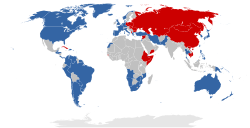
Back العالم الثالث Arabic دول العالم التالت ARZ Трэці свет Byelorussian Трети свят Bulgarian তৃতীয় বিশ্ব Bengali/Bangla Tercer Món Catalan جیھانی سێیەم CKB Třetí svět Czech Y Trydydd Byd Welsh Tredje verden Danish

The term Third World arose during the Cold War to define countries that remained non-aligned with either NATO or the Warsaw Pact. The United States, Canada, Taiwan, Japan, South Korea, Western European countries and other allies represented the "First World", while the Soviet Union, China, Cuba, North Korea, Vietnam, and their allies represented the "Second World". This terminology provided a way of broadly categorizing the nations of the Earth into three groups based on political divisions. Due to the complex history of evolving meanings and contexts, there is no clear or agreed-upon definition of the Third World.[1] Strictly speaking, "Third World" was a political, rather than economic, grouping.[2]
Since most Third World countries were economically poor and non-industrialized, it became a stereotype to refer to developing countries as "third-world countries". In political discourse, the term Third World was often associated with being underdeveloped. China was labeled 'Third World' for several decades in the 20th century before its robust and phenomenal development of the 21st century. Some countries in the Eastern Bloc, such as Cuba, were often regarded as Third World. The Third World was normally seen to include many countries with colonial pasts in Africa, Latin America, Oceania, and Asia. It was also sometimes taken as synonymous with countries in the Non-Aligned Movement. In the dependency theory of thinkers like Raúl Prebisch, Walter Rodney, Theotônio dos Santos, and others, the Third World has also been connected to the world-systemic economic division as "periphery" countries dominated by the countries comprising the economic "core".[1]
In the Cold War, some European democracies (Austria, Finland, Ireland, Sweden, and Switzerland) were neutral in the sense of not joining NATO, but were prosperous, never joined the Non-Aligned Movement, and seldom self-identified as part of the Third World.
Since the dissolution of the Soviet Union and the end of the Cold War, the term Third World has decreased in use. It is being replaced with terms such as developing countries, least developed countries or the Global South.